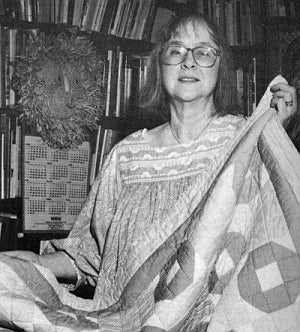
Nancy-Lou studied folklore and fantasy, designed liturgical textiles and stained glass, wrote and illustrated wonderful stories. She had a large family, an extended community of faith, and many colleagues on campus. And for more than thirty years, everyone who studied art at the University of Waterloo got to spend time in her classroom. In the 1980s, I was one of the lucky many, and she reshaped my ideas about art and teaching and living a meaningful life.
Hers was the first classroom where I heard the consistent, enthusiastic use of inclusive language. Hers was the first art history course I took that spot-lit the work of Indigenous artists and called the First Nations by their names. Her history of the world included all the inhabited continents, not just Europe. Her history of art embraced craft and popular culture and mixed media, not just oil paintings and bronze. She championed the art and artists she shared in class, with boundless zeal.
She lavished fierce affection on her students, in all our awkward, eccentric glory. One of my classmates wore a tutu over her jeans for most of the semester. Nancy-Lou didn’t blink. She gave us a drawing assignment about identity and costume. She called one of my pieces “numinous.” I had to go home and look it up—it means filled with a sense of spirituality or divinity—but I have seldom cherished a compliment so much.
I heard from Nancy-Lou’s colleagues that she was unabashed about her generous grades. It wasn’t inflation, she said, it was just that her students all did unusually well in her classes!
I don’t know the origin story of Nancy-Lou’s own signature look but by the time I sat in her classroom, she had adopted a uniform: a no-nonsense pageboy bob and a colourful, comfortable, floor-length “granny gown.” Don’t imagine her as old-fashioned. She was a scholar of visual culture who spoke with equal enthusiasm and expertise about Bernini’s Ecstasy of Saint Teresa and Michael Jackson’s Thriller. Don’t imagine her as delicate, either. Nancy-Lou Patterson persuaded the very new University of Waterloo—as STEM-centric then as it is today—that it needed an art department, and she made it happen.
That Department, that University, and the Region of Waterloo are better places to work and live today because of her contributions. Thank you, Nancy-Lou. You will be missed.
Dr.
Linda
Carson
Lecturer,
Stratford
School
of
Interaction
Design
and
Business
University
of
Waterloo
Photo from UW Gazette circa 1990